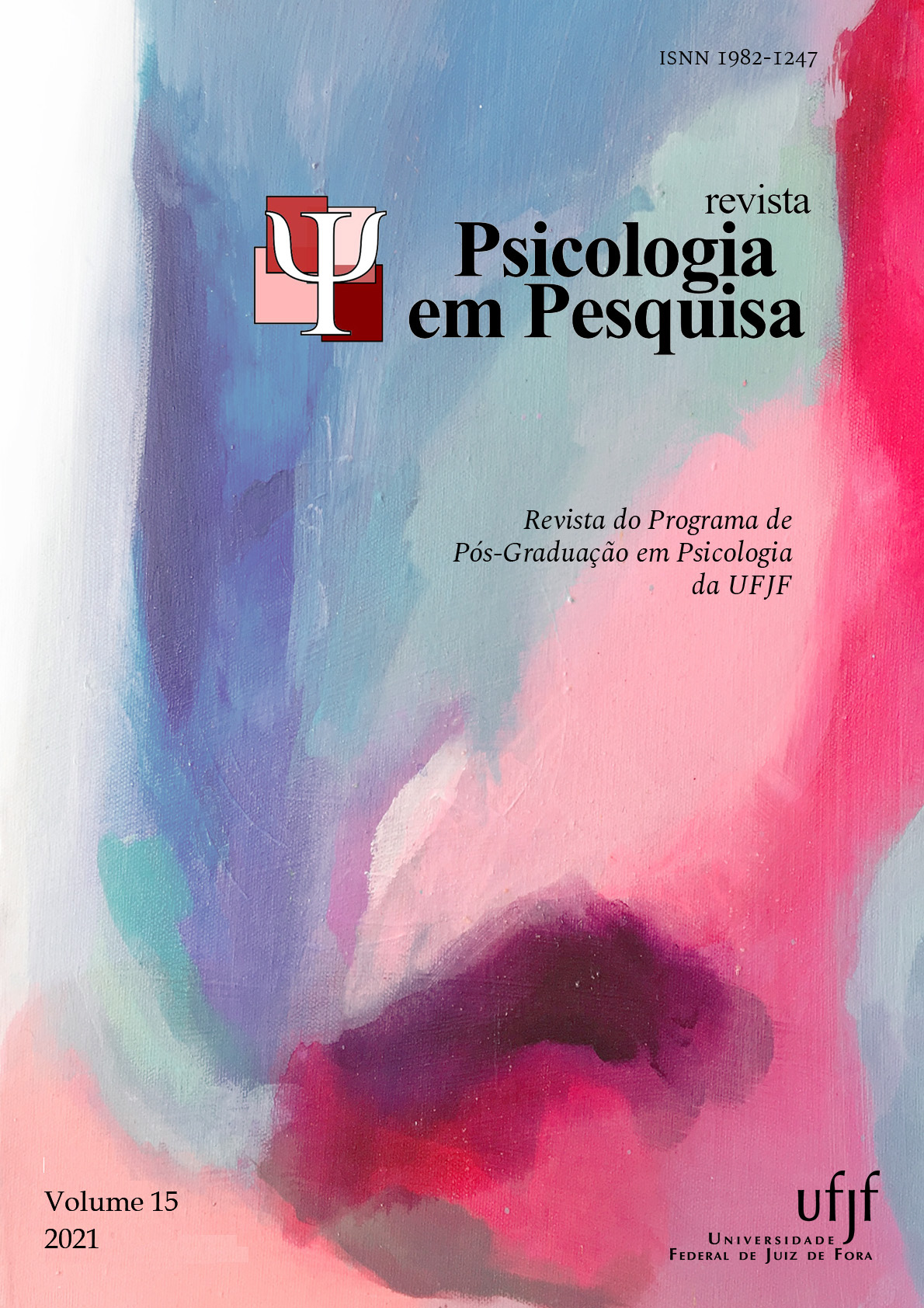Interacción entre polaridades afectivas y espaciales: preferencias futbolísticas y compatibilidade estímulo-respuesta
DOI:
https://doi.org/10.34019/1982-1247.2021.v15.32479Palabras clave:
Emoción, Equipo de fútbol, Tiempo de reacción, Valencia afectiva, Efecto SimonResumen
La valencia afectiva de los estímulos visuales provoca reacciones de aproximación y evitación a estímulos positivos y negativos, respectivamente. En la tarea de Simon, el tiempo de reacción es menor cuando el estímulo y la respuesta están del mismo lado (condición correspondiente) que cuando están en lados opuestos (condición no-correspondiente). La diferencia entre los tiempos de reacción es el efecto Simon. En este trabajo se investigó cómo las valencias afectivas de los equipos Favorito y Rival influyen en el efecto Simon. Los resultados mostraron que el efecto Simon para el equipo Favorito es mayor, lo que sugiere que la valencia positiva del equipo Favorito facilita la respuesta correspondiente.
Descargas
Citas
Cavallet, M., Chaim-Avancini, T. M., Biazoli, C. E., Jr, Bazán, P. R., da Silva, M. A., Cunha, P. J., Miguel, C. S., Busatto, G. F., Louzã, M. R., & Gawryszewski, L. G. (2016). Influence of emotional stimulus valence on inhibitory control in adults with and without ADHD. Experimental Brain Research, 234(11), 3213–3223. https://doi.org/10.1007/s00221-016-4719-0
Conde, E. F. Q., Jazenko, F., Fraga Filho, R. S., da Costa, D. H., Torro-Alves, N., Cavallet, M., & Gawryszewski, L. G. (2011). Stimulus affective valence reverses spatial compatibility effect. Psychology & Neuroscience, 4, 81–87. https://doi.org/10.3922/j.psns.2011.1.010
Conde, E. F. Q., Cavallet, M., Torro-Alves, N., Matsushima, E. H., Fraga-Filho, R. S., Jazenko, F., & Gawryszewski, L. G. (2014a). Effects of affective valence on a mixed Spatial Correspondence Task: A reply to Proctor (2013). Psychology & Neuroscience, 7, 83–90. https://doi.org/10.1037/pne0000147
Conde, E. F. Q., Matsushima, E. H., Torro-Alves, N., Cavallet, M., Jazenko, F., Fraga Filho, R. S., & Gawryszewski, L. G. (2014b). Affective Spatial Compatibility Task (AFFSCT): Theory and applications. Temas em Psicologia, 22, 625–638. http://dx.doi.org/10.9788/TP2014.3-08
Conde, E. F. Q., Lucena, A. O. D. S., da Silva, R. M., Filgueiras, A., Lameira, A. P., Torro-Alves, N., Gawryszewski, L. G., & Machado-Pinheiro, W. (2018). Especialização hemisférica para processamento de fotos relacionadas ao futebol: o papel do fanatismo do torcedor. Psychology & Neuroscience, 11 (4), 329-341. https://doi.org/10.1037/pne0000147
Damatta, R. (1994). Antropologia do óbvio - Notas em torno do significado social do futebol brasileiro. Revista USP, (22), 10-17. https://doi.org/10.11606/issn.2316-9036.v0i22p10-17
Duarte, I. C., Afonso, S., Jorge, H., Cayolla, R., Ferreira, C., & Castelo-Branco, M. (2017). Tribal love: The neural correlates of passionate engagement in football fans. Social Cognitive and Affective Neuroscience, 12, 718–728. https://doi.org/10.1093/scan/nsx003
Gawryszewski, L. G., Lameira, A. P., Ferreira, F. M., Guimaraes-Silva, S., Conde, E. F. Q., & Pereira Jr., A. (2006). A compatibilidade estímulo-resposta como modelo para o estudo do comportamento motor. Psicologia USP, 17(4), 103-121. https://doi.org/10.1590/S0103-65642006000400006
Lien M. C., Proctor, R. W., & Jessica Hinkson, J.(2020) Emotion-induced attentional bias: does it modulate the spatial Simon effect?. Cognition and Emotion. https://doi.org/10.1080/02699931.2020.1785847
Nascimento, P. F. D. D., Lameira, A. P., Torro, N., & Gawryszewski, L. G. (2020). Affective Valence, Spatial Compatibility, and Presidential Candidates: A Study on Political Rivalry in Brazilian Elections. Psychology & Neuroscience. 13,187-195. http://dx.doi.org/10.1037/pne0000199
Proctor, R. W., & Vu, K. P. L. (2006). Stimulus– response compatibility principles: Data, theory, and application. New York, NY: Taylor & Francis.
Proctor, R. W. (2013). Stimulus affect valence may influence mapping-rule selection but does not reverse the spatial compatibility effect: Reinterpretation of Conde et al. (2011). Psychology & Neuroscience, 6, 3–6, 2011. https://dx.doi.org/10.3922/j.psns.2013.1.02
Proctor, R. W., & Xiong, A. (2015). Correspondência de polaridade como um princípio geral de compatibilidade. Current Directions in Psychological Science , 24 (6), 446-451. https://doi.org/10.1177/0963721415607305
Shaffer, L. H. (1965). Choice reaction with variable S-R mapping. Journal of Experimental Psychology, 70, 284–288. https://doi.org/10.1037/h0022207
Schlaghecken, F., Blagrove, E., Mantantzis, K., Maylor, E. A., & Watson, D. G. (2017). Look on the bright side: Positivity bias modulates interference effects in the Simon task. Journal of Experimental Psychology: General, 146(6), 763–770. https:// doi.org/10.1037/xge0000316
Umiltá, C., & Nicoletti, R. (1990). Spatial stimulus-response compatibility. In R. W. Proctor & T. G. Reeve (Eds.), Advances in psychology, Vol. 65. Stimulus-response compatibility: An integrated perspective (p. 89–116). North-Holland.
Wachelke, J. F., Andrade, A. L. D., Tavares, L., & Neves, J. R. (2008). Measurement of identification with soccer teams: Factorial validity evidence and internal consistency of two scales. Arquivos Brasileiros de Psicologia, 60(1), 96–111.
Yamaguchi, M., Chen, J., Mishler, S., & Proctor, R. W. (2017). Flowers and spiders in spatial stimulus-response compatibility: Does affective valence influence selection of task-sets or selection of responses?. Cognition and Emotion, 32, 1003– 1017. https://doi.org/10.1080/02699931.2017.1381073















